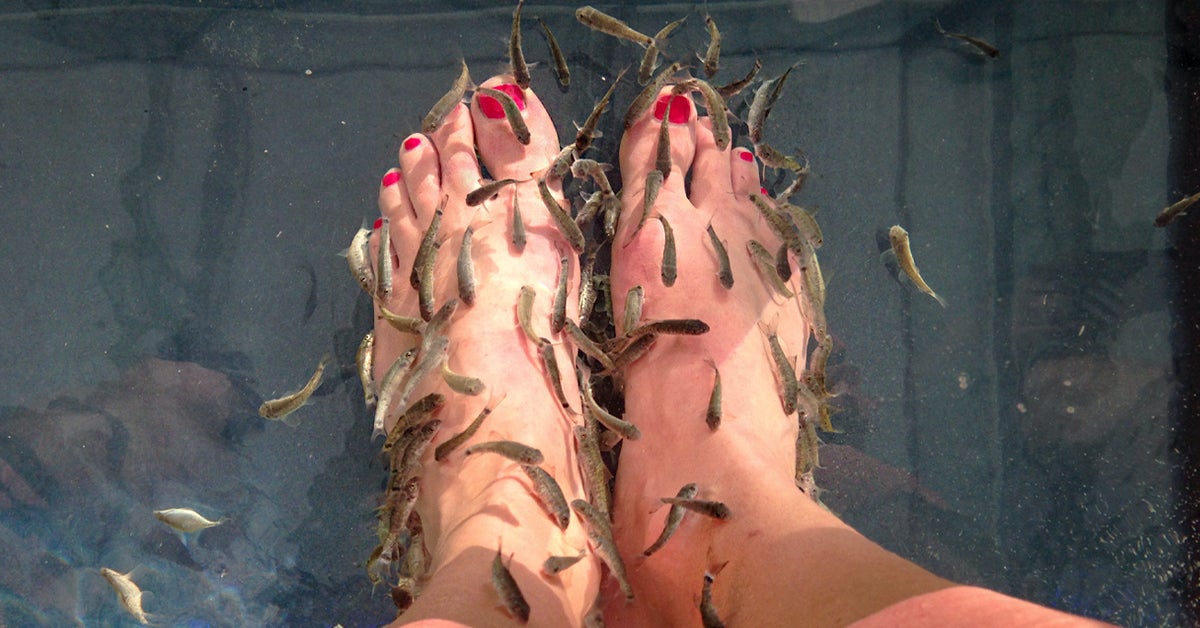
A fish pedicure involves dipping the feet into a basin of water filled with fish. These fish, Garra rufa, sometimes called doctor fish, eat the dead skin off the feet revealing smooth, callous-free skin, and cleaner-looking cuticles.
Fish pedicures are popular in Turkey, where they originated, and other Middle Eastern countries. Garra rufa fish are native to the Middle East and Southeast Asian countries. They are allowed in certain places in the United States.
The procedure became popular because the fish are able to exfoliate and soften the feet in a non-painful way. The fish pedicure tickles but does not hurt. However, these pedicures pose both health and environmental risks, and are actually banned in many U.S. states and parts of Canada and Europe.
There are several reasons fish pedicures may be considered risky or unsafe. Here are the safety concerns of fish pedicures:
- It’s difficult to sanitize the basins between patrons because the fish would need to be removed, and the fish themselves cannot be sanitized.
- Some Garra rufa may be confused with another species of fish, Chinchin, which can grow teeth and bite, causing pain and increasing the risk of infection.
- There have been reports of staph infections after fish pedicures as a result of pathogenic bacteria in the fish.
- Onychomadesis can occur after a fish pedicure, which is when the toenails blacken and fall off. This is likely caused by trauma to the nail from the pressure of the fish.
- In at least one case, mycobacteriosis, a bacterial infection resulting in rough plaque on the skin, has been reported after a fish pedicure.
- There is a small risk of blood-borne diseases passing between customers if one person has an open cut that bleeds into the basin.
The purported benefits of fish pedicures include reduced callouses, smooth skin on the feet, and exfoliation of dry skin and rough patches. A pedicure done by a human from a trusted salon will do the same, however, and so will at-home use of a pumice stone or a foot scrub. The risks of fish pedicures outweigh the benefits.
One study found a 72 percent reduction of psoriasis in people undergoing ichthyotherapy, or using Garra rufa to treat conditions, though there are other treatments that don’t carry risks.
At least 14 states have banned fish pedicures, including:
- Texas
- New York
- New Jersey
- California
- Washington
- Maine
- Massachusetts
They are also banned in Mexico, parts of Europe, and parts of Canada.
There are also ethical concerns associated with fish pedicures.
- Because the fish are not native to North America, many will die in transit.
- If they are released into the water, they introduce a non-native species that can disrupt the ecosystem.
- Garra rufa will only eat dead skin if they are starving, so the fish are not given other food.
- In certain parts of the world, Garra rufa are overfarmed to provide enough for pedicures.
Fish pedicures at a salon involve putting the feet in a basin of water filled with Garra rufa, a fish native to the Middle East. The purported benefits are smoother feet and potentially less psoriasis, but the safety and ethical concerns — including potential for infection and lack of sanitation between customers — outweigh the benefits.
June 01, 2021 at 10:38PM
https://ift.tt/3yWdGSs
Fish Pedicure: Risks, Benefits, Safety, and Ethical Concerns - Healthline
https://ift.tt/35JkYuc
Fish
No comments:
Post a Comment